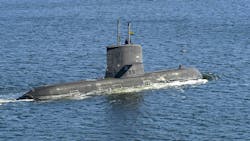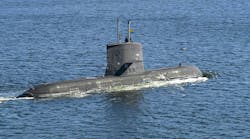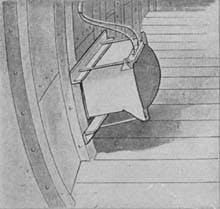Stemming the EMI Tide in Submarines
- What are the EMI challenges in submarines?
- EMI mitigation strategies for underwater systems.
Electromagnetic interference (EMI) may affect the performance of any onboard electronic systems in a submarine. Key points about EMI in these vessels include:
- Sources of EMI: EMI can originate from various sources, including onboard equipment, external electromagnetic fields, and even natural phenomena like lightning.1
- Impact on systems: EMI may disrupt communication systems, navigation equipment, and other critical electronic systems on a submarine. This can lead to malfunctions or degraded performance.2
- Mitigation strategies: To minimize EMI, submarines use shielding, grounding, and filtering techniques. Proper cable management and the use of EMI-resistant materials are also essential.3
- Standards and regulations: The Navy has specific standards and procedures for managing EMI, such as the MIL-STD-461F and MIL-STD-464C, which outline requirements for electromagnetic compatibility and emissions.4
- Technological advances: Modern submarines are increasingly using advanced technologies to detect and mitigate EMI, ensuring the reliability and safety of their operations.5
Electromagnetic Propagation Underwater
Extremely low frequency (ELF) for a submarine communications system is most likely to be the only successfully deployed undersea electromagnetic application.5 This system is operated at 76 Hz for the United States system and 82 Hz in the Russian system. This communication platform enables transmission of just a few characters per minute, all across the Earth.
This amazing system implements a one-way “bell ring” to contact an individual submarine to surface so that it can use a higher-bandwidth communications system via terrestrial radio. In water, long-range, full-bandwidth, analog voice communications were deemed to not be a practical solution. Technology designers came to realize that electromagnetic signals would have no applications in an underwater environment.
Policies in Place for Marine Vessel EMI
Reference 1 has “added policies for ship electromagnetic compatibility (EMC) and radiation hazards (RADHAZ) certifications as well as shipboard EMC and RADHAZ assessments for systems to be operated aboard ships and submarines.” All ships must be certified for EMC and RADHAZ prior to deployment. Consistent with the reference, all submarines will be surveyed for EMI prior to deployment.
>>Download the PDF of this article, and check out the TechXchange for similar articles and videos
Below deck areas:2 These areas within ships, including submarines, have a metallic structure like a hull or superstructure. Another area would be the screened areas of some ships that employ a combination of metallic and/or non-metallic materials for their hull, superstructure, or also possibly a metallic deck-mounted shelter.
Another area of concern surrounds high-speed brushless DC (BLDC) motors, which are used in naval and commercial submarines. Due to high-speed switching circuits used in the commutation circuits, a BLDC motor will typically contribute to high EMI complications. Policies like those below have been created to combat the problem.
Reference 1 states: “If an authorized fix is readily available for a shipboard EMI problem, then the fix must be implemented prior to operational use of the affected equipment, system, or platform. If a fix has been approved but is not available, it must be tracked per reference (n), volume VI, to be resolved during the next scheduled maintenance availability.”
Also from Reference 1: “Consistent with reference (a), all ships must be certified for EMC and RADHAZ prior to deployment. Consistent with reference (n), all submarines will be surveyed for EMI prior to deployment.”
“Responsibilities, section (b), (1) Manage the shipboard electromagnetic and compatibility improvement program (SEMCIP) to prevent, detect, measure, analyze, report, and correct EMI deficiencies and address SS issues.”
And reference 4 states: “Manage the shipboard electromagnetic and compatibility improvement program (SEMCIP) to prevent, detect, measure, analyze, report, and correct EMI deficiencies and address spectrum supportability (SS) issues.”
A submarine bell, which is in use on the lightships, becomes actuated via compressed air stored in a reservoir. The actuating wheel is designed with projections mounted on it so that when the wheel revolves, a number of strokes follow each other. The different intervals are peculiar to the different signal stations. Therefore, the captain of the ship, by counting the strokes of the bell, can decide which lightship is producing the sound (see figure).
Submarine EMI Strategies and Challenges
There are challenges analogous with subsea EMI mitigation.8 Designers are researching strategies that are based on lessons learned during the design and testing phases of submarine systems for a wide range of subsea applications.
Compared to terrestrial applications, EMI and EMC standardization is quite narrow in subsea applications. Thus, mitigation strategies are often reactive rather than preventative. EMI sources will typically remain the same with DC-DC converters or motors, in addition to their associated drivers being common sources in subsea applications.
Don’t Overlook EMI in a Closed Submarine Environment
EMI interference sources must be weighed heavily on a submarine because serious equipment malfunctions will likely occur if the EMI isn’t controlled in such a susceptible, closed metal environment—especially when new systems are added. Such systems could also become susceptible to an intense electromagnetic environment (EME).
In addition, the corrosive, saltwater environment along with the interaction of a ship’s electrically conductive metallic superstructure, topside hardware, antenna systems, etc., significantly increases the potential for interoperability issues.
References
1. “Electromagnetic Environmental Effects and Spectrum Supportability Program and Procedures,” NAVSEA Instruction 2400.20A, Department of the Navy, Naval Sea Systems Command, Dec. 27, 2022.
2. Department of Defense Standard Practice: “Shipboard Bonding, Grounding, and Other Techniques for Electromagnetic Compatibility, Electromagnetic Pulse (EMP) Mitigation, and Safety, Inch-Pound, MIL-STD-1310H(NAVY)," Sept. 17, 2009.
3 COMFLTFORCOMINST 4790.3D, Joint Fleet Maintenance Manual, Jan. 15, 2021.
4 OPNAVINST 2400.200, “Electromagnetic Environmental Effects and Spectrum Supportability Policy and Procedures,” Jan. 7, 2021.
5. “Technology in Focus: Underwater Electromagnetic Propagation, Re-evaluating Wireless Capabilities,” Hydro-international.com, January 1, 2008.
6. Lightship’s Submarine Bell, US Coast Guard Sailors Association International, Inc.
7. "Wireless Power Transfer to Underwater Vehicles (Submarines) by Electromagnetic Induction," Prathamesh Vaishali Arun Patil, Shubham Sangita Kailas Ahire, Samarth Neha Sharad Gavali, Devesh Kalpana Bhagwat Dhake, Yashwant Sangita Dhanraj Mahajan, Student, Assistant Professor, Department of Electrical Engineering, Sandip Polytechnic, Nashik, International Journal of Research Publication and Reviews, Vol 5, no 8, pp 4454-4458, Aug. 2024.
8. “An Introduction to Subsea Electromagnetic Interference Strategies and Challenges,” Scott Williams, OceanWorks International Corp.; Scott McLean, Ocean Networks Canada Innovation Centre, 2015.
>>Download the PDF of this article, and check out the TechXchange for similar articles and videos
About the Author

Steve Taranovich
Freelance Technical Writer, Phoenix Information Communication LLC
Steve is a contributing editor to Electronic Design.
Author of the non-fiction “Guardians of the Right Stuff,” a true story of the Apollo program as told by NASA and Grumman Corp. engineers, an astronaut, and technicians.
Experienced Editor-In-Chief of EETimes/Planet Analog and Senior Technical Editor at EDN running the Analog and Power Management Design Centers from 2012 to 2019.
A demonstrated history in electronic circuit design and applications for 40 years, and nine years of technical writing and editing in industry. Skilled in Analog Electronics, Space-related Electronics, Audio, RF & Communications, Power Management, Electrical Engineering, and Integrated Circuits (IC).
1972 to 1988 worked as a circuit design engineer in audio (8 years) and microwave (8 years). Then was Corporate Account Manager/applications engineer for Burr-Brown from 1988 to 2000 when TI purchased Burr-Brown. Worked for TI from 2000 to 2011.
Strong media and communication professional with a BEEE from NYU Engineering in 1972 and an MSEE from Polytechnic University in 1989. Senior Lifetime member of IEEE. Former IEEE Long Island, NY Director of Educational Activities. Eta Kappa Nu EE honor society member since 1970.



